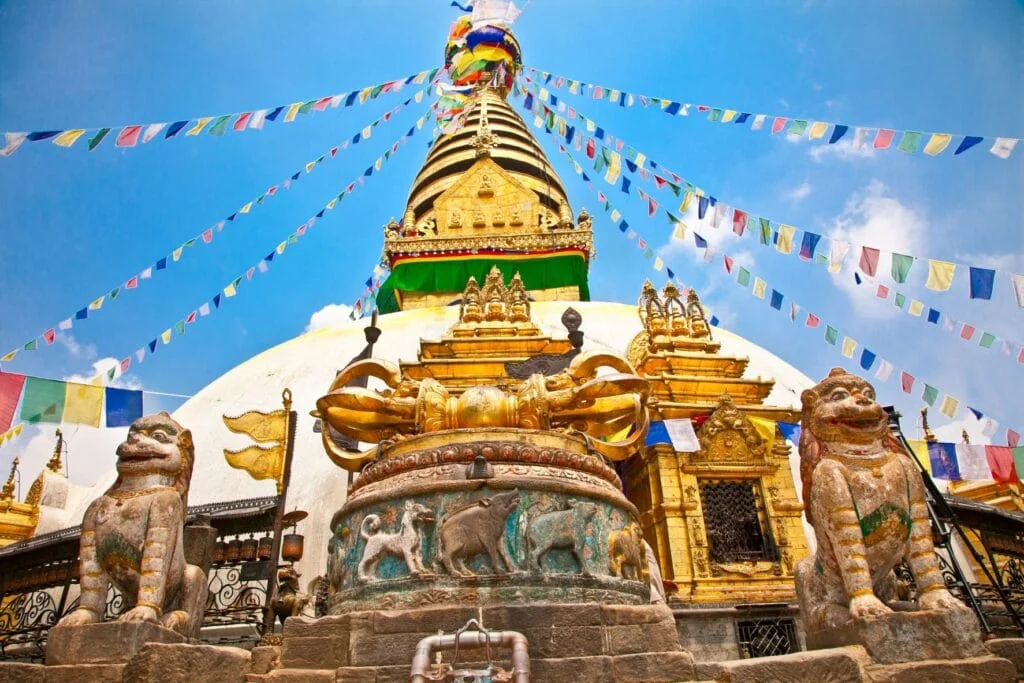Swayambhunath Stupa :The Timeless Icon of Kathmandu, Nepal
Introduction
Perched atop a hill in the Kathmandu Valley, Swayambhunath Stupa, also known as the Monkey Temple, is one of Nepal’s most iconic landmarks. Overlooking the city, this sacred site embodies Nepal’s deep spiritual heritage and centuries of history. Whether you are a pilgrim, a history enthusiast, or a traveler seeking panoramic views of Kathmandu, Swayambhunath Stupa offers an unparalleled experience.
Designated as a UNESCO World Heritage Site, Swayambhunath is among Nepal’s oldest and most revered religious monuments. This article explores Swayambhunath Stupa’s history, architectural wonders, spiritual significance, and visitor information, ensuring you make the most of your trip to this magnificent Buddhist sanctuary.
The History of Swayambhunath Stupa
The origins of Swayambhunath Stupa Nepal date back over 2,500 years, making it one of the oldest Buddhist structures in the world. According to historical texts and legends, the stupa emerged from a primordial lake that once covered the Kathmandu Valley. A Bodhisattva, Manjushri, is said to have drained the lake by slicing through the hills, allowing human civilization to flourish around the sacred site.
The stupa was built in its current form by King Vrsadeva in the 5th century AD, with later additions by rulers from the Malla and Shah dynasties. Over centuries, it has remained a central site for Tibetan Buddhists, Hindus, and other spiritual seekers.
“Swayambhunath represents Nepal’s rich cultural tapestry, where Hinduism and Buddhism coexist harmoniously,” says historian Deepak Shrestha.
Architectural Marvel: The Design of Swayambhunath Stupa
A Symbol of Enlightenment
The Swayambhunath Stupa architecture is a masterpiece of Buddhist symbolism. Its white dome represents the world, while the 13 golden spires above signify spiritual enlightenment stages. The most striking feature is the all-seeing eyes of Buddha, painted on four sides of the square base, symbolizing wisdom and omnipresence.
Prayer Wheels and Shrines
Encircling the stupa are prayer wheels inscribed with the mantra “Om Mani Padme Hum.” Visitors can spin these wheels while walking clockwise; a traditional practice believed to accumulate good karma.
Additionally, the complex houses numerous Hindu and Buddhist shrines, reflecting Nepal’s religious inclusivity. Statues of Padmasambhava (Guru Rinpoche), Avalokiteshvara, and Tara add to its spiritual depth.
Visiting Swayambhunath Stupa: Practical Information
Swayambhunath Stupa Visiting Hours
The stupa is open 24/7, but the best time to visit is early morning (before 9 AM) or late afternoon when crowds are thinner, and the golden hues of sunrise and sunset create a mesmerizing ambiance.
Swayambhunath Stupa Entrance Fee
As of 2024, the entrance fee for international visitors is NPR 200 (approx. USD 1.50). SAARC nationals pay NPR 50, while Nepali citizens can visit for free.
Swayambhunath Stupa Location & How to Get There
The stupa is located 2.5 km west of Kathmandu’s Thamel district. Visitors can reach it via:
- Taxi: A ride from central Kathmandu costs around NPR 500-800.
- Walking: A 30-40 minute scenic walk from Thamel.
- Public Transport: Local microbuses from Ratnapark stop near the base of the hill.
Join Us in a Buddhist Monastery – Apply Now and Transform Your Life!
Cultural and Religious Significance
Why is Swayambhunath Stupa Important?
1. Spiritual Powerhouse
Revered by Buddhists and Hindus, the stupa is a pilgrimage site where daily prayers and rituals are performed. It is a key site for Tibetan Buddhist festivals like Losar (Tibetan New Year) and Buddha Jayanti.
2. Symbol of Harmony
Swayambhunath exemplifies Nepal’s unique religious harmony, where prayer flags flutter alongside Hindu deities and Buddhist monks chant alongside Hindu sadhus.
3. Monkey Kingdom
Home to hundreds of rhesus macaques, the stupa earned the nickname “Monkey Temple.” While entertaining, visitors should be cautious as the monkeys can be mischievous.
Swayambhunath Stupa Restoration and Preservation
Impact of the 2015 Earthquake
The 2015 Nepal earthquake caused significant damage to some surrounding shrines, but the main stupa remained largely intact. Restoration efforts, led by Nepal’s Department of Archaeology and UNESCO, have since reinforced the structure.
Ongoing Conservation
Today, conservationists and volunteers work tirelessly to maintain the site’s integrity. Visitors can contribute by respecting local customs, avoiding littering, and supporting restoration initiatives.
Frequently Asked Questions (FAQs)
1. Why is Swayambhunath Stupa called the Monkey Temple?
It is home to numerous rhesus monkeys, considered sacred in Hindu and Buddhist traditions.
2. What is the best time to visit Swayambhunath Stupa?
Early morning (before 9 AM) or late afternoon offers the best lighting and fewer crowds.
3. How long does it take to explore Swayambhunath?
A typical visit lasts 1.5 to 2 hours, but those interested in meditation and photography may stay longer.
4. Can I take photos at Swayambhunath?
Yes! Photography is allowed but avoid disturbing worshippers.
5. What are the dos and don’ts at Swayambhunath?
- Do: Walk clockwise, remove shoes before entering temples, and spin prayer wheels.
- Don’t Feed the monkeys or climb onto the stupa.
6. Is there a dress code for visiting the stupa?
Dress modestly by covering shoulders and knees, as it is a religious site.
7. Are there food stalls near Swayambhunath?
Several tea shops and local eateries offer snacks and traditional Nepali food near the entrance.
Call to Action: Support Nepal’s Heritage Through Volunteering
Swayambhunath is more than a monument—it is a living symbol of Nepal’s rich cultural heritage. ViN (Volunteers Initiative Nepal) actively works on community-based tourism, heritage conservation, and volunteer projects that help preserve Nepal’s historical landmarks.
How You Can Help:
- Volunteer with ViN: Support community-based heritage conservation projects.
- Internship Opportunities: Gain hands-on experience in cultural preservation.
- Donate: Contribute to ViN’s education, disaster relief, and conservation initiatives.
Explore Nepal beyond its tourist sites—engage, contribute, and make an impact!
Share this article with friends and family who love history, culture, and travel. Let’s keep Nepal’s heritage alive for future generations.
“Ready to Start Your Adventure? Contact Us for More Details!”
